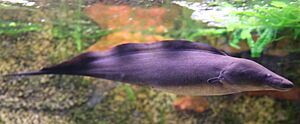Hans Lissmann (zoologist) facts for kids
Quick facts for kids
Hans Lissmann
|
|
|---|---|
 |
|
| Born | 30 April 1909 |
| Died | 21 April 1995 (aged 85) Cambridge, England
|
| Alma mater | Hamburg |
| Occupation | Zoologist |
| Spouse(s) | Corinne Ceresole Foster-Barham |
Hans Lissmann (born April 30, 1909 – died April 21, 1995) was a British zoologist. He was born in Ukraine and became famous for studying how animals behave.
In 1954, he became a Fellow of the Royal Society. This happened after he and his assistant, Kenneth E. Machin, made an amazing discovery. They found out that the African Knife fish (Gymnarchus) creates its own electric field. They also learned how the fish uses this special ability.
From 1966 to 1977, he was a Reader in the Department of Zoology at the University of Cambridge. He also directed the Sub-Department of Animal Behaviour.
Contents
Hans Lissmann's Life Story
Growing Up
Hans Werner Lissmann was born in Mykolaiv, Ukraine. At that time, Ukraine was part of Russia. His family was wealthy and had German roots. When World War I started in 1914, his family was seen with suspicion. Hans and his older brother were sent away to a place called Siberia, far from their parents.
After the war ended, they were allowed to go home. But by 1922, his family moved to Hamburg in Germany. This is where Hans went to school.
Studying and Moving
In the late 1920s, Lissmann began studying Biology at the University of Hamburg. He then worked with a famous scientist named Jakob von Uexküll. In 1932, Hans earned his doctorate degree for his studies on the Siamese fighting fish.
In 1933, he traveled to a research station in Hungary. While he was there, big political changes happened in Germany. Hans didn't agree with the new government's ideas. So, he decided to leave Germany. He traveled all the way to India.
From India, he received help from a group called the Academic Assistance Council. This help allowed him to move to Great Britain. In 1934, he got a job at the Cambridge University Zoological Institute. There, he worked with another important scientist, James Gray. In his early years at Cambridge, Hans studied how animals move, use their senses, and how their nervous systems work together.
Fish and Electricity
A very important discovery happened in 1950. The year before, Lissmann visited the London Zoo. He noticed something amazing about the African knife fish (Gymnarchus). This fish could swim backwards just as easily and quickly as it swam forwards! It could even avoid obstacles without bumping into them.
Hans thought the fish must have a special "sixth sense." He also noticed something similar with an electric eel nearby. He wondered if electricity was involved.
In late 1949, Lissmann got married. As a wedding gift, a friend gave him his very own knife fish! He took it to his lab to study it. He put the fish in a large tank and added special tools called electrodes. With these, he could detect a natural electric current coming from the fish. This current was too weak for a person to feel.
He then found ways to make the current stronger so he could measure it with a machine called an oscilloscope. There's a story that the fish even made a stronger electric charge when a student combed her hair next to the tank!
The first fish died, but Hans got new ones. Working with his talented assistant, Kenneth E. Machin, Lissmann proved his idea. They showed that the knife fish itself produced a changing electric charge. They also found that the fish reacted to any changes in the electric field around it. This happened even if the change was outside the tank!
Ken Machin even built a clear plastic model of an African knife fish. This model had electrodes that could create an electric field like the real fish. Even though the model couldn't perfectly copy the real fish's electric field, it helped them gather a lot of valuable information.
Their main conclusion was incredible: the African knife fish uses changes in the electric field around it to sense its surroundings. It then uses this information to decide how to act.
Family Life
Hans Lissmann married Corinne Ceresole Foster-Barham in Cambridge in 1949. Their son, Martin, became a doctor in Essex. Martin also enjoyed playing the flute.
Writings
Hans Lissmann wrote many scientific papers about his discoveries. Here are a few examples:
- "The Environment of the Siamese Fighting Fish (Betta splendens Regan)" (1932)
- "Continuous Electrical Signals from the Tail of a Fish, Gymnarchus Niloticus Cuv" (1951)
- "The Mechanism of Object Location in Gymnarchus Niloticus and Similar Fish" (1958) (with Ken E. Machin)
- "Electric Location by Fishes" (1963)


